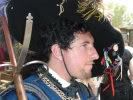Cheness "Oniyuri" katana
Apr 3, 2009 3:31:53 GMT
Post by ecovolo on Apr 3, 2009 3:31:53 GMT
Ack! A new template?! However will I follow this? I was just getting used to the *old* template! ;D
Ah well-- I'll give it my best shot, using the new-fangled template:
Introduction
My name is ecovolo, and I am giving a review of Cheness' "Oniyuri" katana:
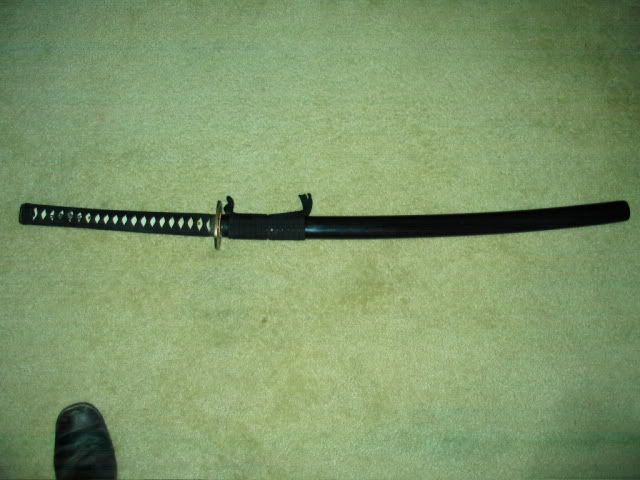
(Apologies for the atrocious pictures. This is about as good as they get, and the camera is about ready to give up the ghost.)
What attracted me to this blade were two things: First I was looking for a "ninja sword" per se, and second, something that didn't look like the 'usual' straight-bladed ninja katana found on most sword sites. My searches have yielded no online proof regarding what an actual ninja katana --or shinobigatana, depending upon how you want to look at it-- looked like. After looking at several Hollywood straight-bladed versions, I came across this one, on the Cheness website: www.chenessinc.com/9260oniyuri.htm . The site also states that it was made for the "Bujinkan Federation"-- I don't know what that is, but it sounds impressive . The unusual construction intrigued me, and I found the $249 pricetag within my budget, so I ordered one.
. The unusual construction intrigued me, and I found the $249 pricetag within my budget, so I ordered one.
Historical overview
As much as I tried to find photos or museum pics of ninja katana/shinobigatana online, I couldn't. I found tons of B-rated movie ads and some 1980's movie references ("Revenge Of The Ninja", anyone? ;D), and a few verbal descriptions a la Wikipedia: en.wikipedia.org/wiki/Ninja_sword . I'd show a picture of an historical ninja sword if I could find one, and I'm sure that picture is hiding somewhere-- much like a real ninja ;D. So, I'll just have to take it on faith that this is a good approximation.
Initial Impressions

The sword came in a reasonable amount of time from Cheness-- I'll recommend their customer service; I have no complaints. The sword itself was wrapped in a lined black cotton bag, within a double-latched wood-and-styrofoam box. The box is covered in a brocade fabric; the inside looks like it's lined with a polyester/satin material. What grabbed me about the weapon when I took it out of the bag was the fact that the tsuka is *long*. More info about it further down the review.
Statistics
Blade/Nagasa Length: Per the website: blade length is 23 inches.
Handle/Tsuka Length: Per the website: 14 inches.
Overall Length: Per the website, and in the saya: 44.5 inches.
Guard/Tsuba Width: 3 inches by 3 1/2 inches.
POB (Point of Balance): Per the website: 2.5 inches above tsuba (with fuller), 3 inches above tsuba (without fuller). Note that the version I bought came without the fuller.
COP (Center of Percussion): Per my experience practicing tameshigiri with this sword, I'd say about 13 to 16 inches up from the tsuba.
Weight: Per the website: 2 lbs 8 oz (with fuller), 2 lbs 12 oz (without fuller). Note again that the version I bought has no fuller.
Components:
Note here that I do not trust my ability to disassemble and reassemble the weapon, so I will go with the initial, visible impressions of the complete weapon versus a disassembled view:
The Blade/Nagasa
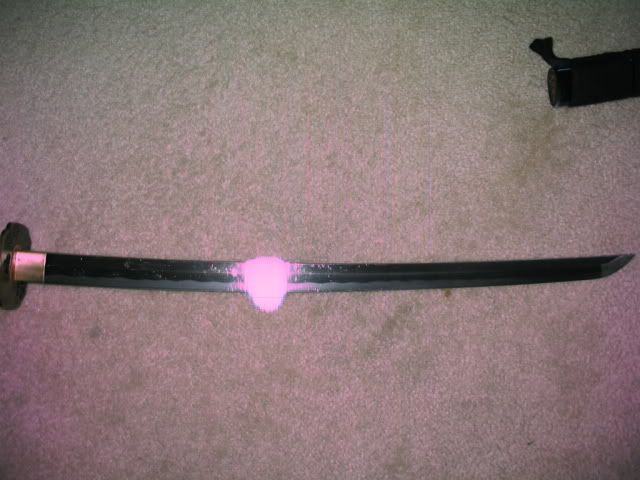
The blade is 23 inches long and 1 and 1/2 inches wide. I am a believer in beefier blades when it comes to cutting/tameshigiri, so I was pleased by this. The hamon is the usual Cheness acid etch, the kissaki is separately ground and highly visible. The boshi is visible, but barely so. The mune is *straight*-- no deviations, and the blade has a gentle sori of just half an inch. At a guess, the blade style appears to be shinogi zukuri. The habaki is the same brass habaki you find on most production blades made today; nothing of particular note.
The Handle/Tsuka
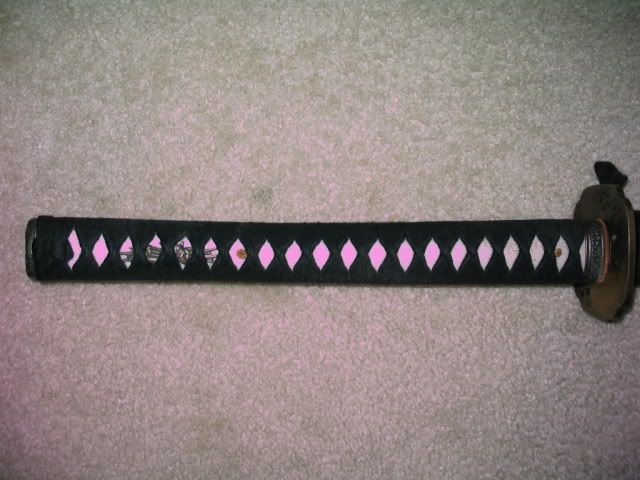
The tsuka is wood, covered in white same' with a black cotton ito. Per the website, the fuchi and kashira are an alloy; they have a pebbly kind of pattern on them that reminds me of cobblestones or a *bad* case of psoriasis ;D. Of note is that the tsuka is *14 inches long*. I found this actually a benefit, in that it gave me more variety as to how I would like to grasp the weapon closer, or further, to the tsuba than most *normal* katana. Here is a picture for comparison:
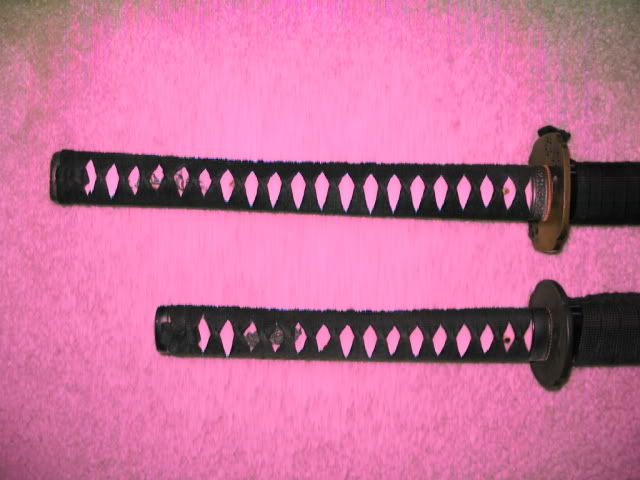
The top tsuka is the Oniyuri; the bottom one is the Cheness 1060 Mokko-- notice the difference in length! Experience with the Oniyuri has shown me that the tsuka was quite comfortable in my grip-- not boxy or unwieldy. It is double-pegged, with the mekugi-ana 1 1/4 inches and 8 3/4 inches away from the tsuba, and the mekugi are durable wood pegs that keep the tsuka *securely* in place.
Of particular note are the menuki:
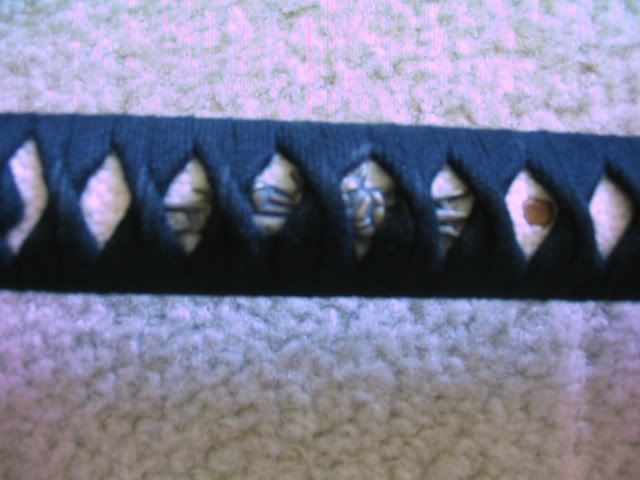
. . . I'm not really sure what it is, and after some study I can only guess it's a "demon/dragon/fish". So far, this is the only katana I have bought to date with demon-dragon-fish menuki. Unique, if somewhat puzzling.
The Guard/Tsuba
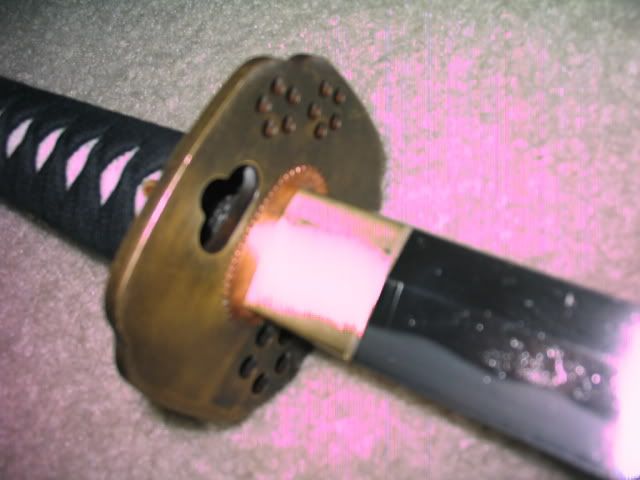
The tsuba is a rather plain brass tsuba with three circles of holes in it. I can only assume that these holes are symbolic of an "Oniyuri" (help on this one?). The seppa on either side of the tsuba appear to be copper. There are hitsu-ana for kogai and kozuka, but the sword did not come with kogai and kozuka, and I don't intend on buying any for it .
.
The Pommel/Fuchi-Kashira
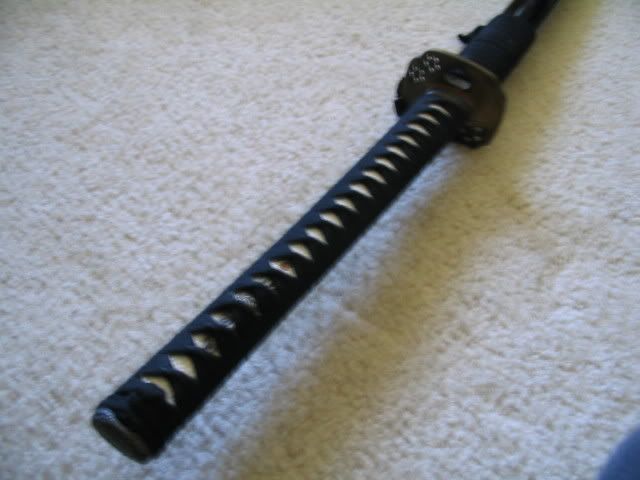
As stated before, the fuchi and kashira have a pebbly pattern to them that reminded me of cobblestones . . . or psoriasis. Not particularly eye-catching, but then, this is supposed to be the weapon of a ninja-- it's not *supposed* to catch your eye .
.
The Scabbard/Saya
As shown in two of the pictures above, the saya is wood with a black glossy finish. The sageo is black cotton, and there is no ornamentation on the saya to speak of.
Handling Characteristics
When practicing cutting/ tameshigiri, I found the sword relatively easy to handle. The unfullered blade was not too heavy; I attribute this to the fact that it is *shorter* than the "average" katana blade. Consider this photo for a comparison:
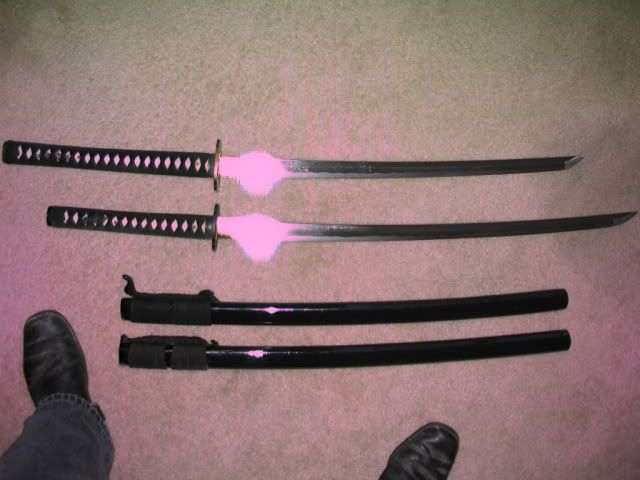
The bottom one is the Cheness 1060 Mokko. Measuring from the tsuba, notice that the Oniyuri (on top) has a shorter blade and longer handle, as stated before. To me, this actually made it more maneuverable. I'm a 5'8" swordsman-- so for me, this works out quite well: a shorter blade + a longer handle = *faster* handling when it came to practicing katas and tameshigiri.
Test Cutting
Unfortunately, I have no video. Test cutting with the Oniyuri was delightful; I can honestly say that the only problems I had were the result of my own bad form. The targets I had were tatami mats and plastic two-liter bottles. While I have no pictures of the dead tatami, I do have a few end-result pictures of the 2-liters:
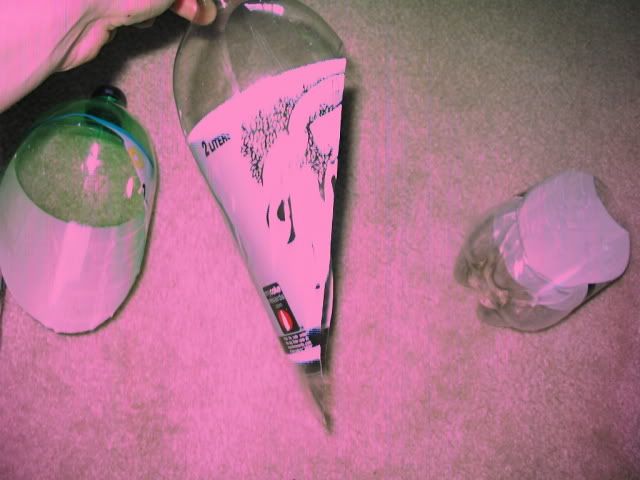
(Above photo) That *used* to be a Barq's bottle. Now it's recycling-bin fodder .
.

(Above photo) The upper left portion of the cut shows my bad form .
.
All in all, I have no complaints when practicing cutting/ tameshigiri with the Oniyuri.
Conclusions
Overall: I was pretty pleased. Cheness already redesigned the blade once, changing out the tsuba. I can only guess that this was to make the blade more 'ninja-looking', but to me it just looks fine as it is, demon-dragon-fish menuki and cobblestone/psoriasis fuchi and kashira included . I *will* order from Cheness again.
. I *will* order from Cheness again.
Pros
- Solid tsuka; no problems with wobbling or movement
- The long tsuka is a benefit to adjust for grip
- The shorter blade = faster draw time and speed to the cut
*Minor* Cons
- Aesthetically, they could have used a prettier fuchi and kashira
- Perhaps the option for a black same'?
The Bottom Line
My summary: I would recommend this sword to anyone who has a fascination with ninja swords or ninjas in general. It's different from the "average" straight-bladed ninja sword that pervades so many sword sites, and to me, it seems to be a little more believable as a historically accurate piece versus those straight-bladed weapons. As a cutting blade, it performed pretty well. Not the *prettiest* katana you'll find, but it cuts with no problems. Worth the money paid for it.
--Edward
P.S. As this is only my second review, any comments or advice is appreciated .
.
Ah well-- I'll give it my best shot, using the new-fangled template:
Introduction
My name is ecovolo, and I am giving a review of Cheness' "Oniyuri" katana:

(Apologies for the atrocious pictures. This is about as good as they get, and the camera is about ready to give up the ghost.)
What attracted me to this blade were two things: First I was looking for a "ninja sword" per se, and second, something that didn't look like the 'usual' straight-bladed ninja katana found on most sword sites. My searches have yielded no online proof regarding what an actual ninja katana --or shinobigatana, depending upon how you want to look at it-- looked like. After looking at several Hollywood straight-bladed versions, I came across this one, on the Cheness website: www.chenessinc.com/9260oniyuri.htm . The site also states that it was made for the "Bujinkan Federation"-- I don't know what that is, but it sounds impressive
 . The unusual construction intrigued me, and I found the $249 pricetag within my budget, so I ordered one.
. The unusual construction intrigued me, and I found the $249 pricetag within my budget, so I ordered one.Historical overview
As much as I tried to find photos or museum pics of ninja katana/shinobigatana online, I couldn't. I found tons of B-rated movie ads and some 1980's movie references ("Revenge Of The Ninja", anyone? ;D), and a few verbal descriptions a la Wikipedia: en.wikipedia.org/wiki/Ninja_sword . I'd show a picture of an historical ninja sword if I could find one, and I'm sure that picture is hiding somewhere-- much like a real ninja ;D. So, I'll just have to take it on faith that this is a good approximation.
Initial Impressions

The sword came in a reasonable amount of time from Cheness-- I'll recommend their customer service; I have no complaints. The sword itself was wrapped in a lined black cotton bag, within a double-latched wood-and-styrofoam box. The box is covered in a brocade fabric; the inside looks like it's lined with a polyester/satin material. What grabbed me about the weapon when I took it out of the bag was the fact that the tsuka is *long*. More info about it further down the review.
Statistics
Blade/Nagasa Length: Per the website: blade length is 23 inches.
Handle/Tsuka Length: Per the website: 14 inches.
Overall Length: Per the website, and in the saya: 44.5 inches.
Guard/Tsuba Width: 3 inches by 3 1/2 inches.
POB (Point of Balance): Per the website: 2.5 inches above tsuba (with fuller), 3 inches above tsuba (without fuller). Note that the version I bought came without the fuller.
COP (Center of Percussion): Per my experience practicing tameshigiri with this sword, I'd say about 13 to 16 inches up from the tsuba.
Weight: Per the website: 2 lbs 8 oz (with fuller), 2 lbs 12 oz (without fuller). Note again that the version I bought has no fuller.
Components:
Note here that I do not trust my ability to disassemble and reassemble the weapon, so I will go with the initial, visible impressions of the complete weapon versus a disassembled view:
The Blade/Nagasa

The blade is 23 inches long and 1 and 1/2 inches wide. I am a believer in beefier blades when it comes to cutting/tameshigiri, so I was pleased by this. The hamon is the usual Cheness acid etch, the kissaki is separately ground and highly visible. The boshi is visible, but barely so. The mune is *straight*-- no deviations, and the blade has a gentle sori of just half an inch. At a guess, the blade style appears to be shinogi zukuri. The habaki is the same brass habaki you find on most production blades made today; nothing of particular note.
The Handle/Tsuka

The tsuka is wood, covered in white same' with a black cotton ito. Per the website, the fuchi and kashira are an alloy; they have a pebbly kind of pattern on them that reminds me of cobblestones or a *bad* case of psoriasis ;D. Of note is that the tsuka is *14 inches long*. I found this actually a benefit, in that it gave me more variety as to how I would like to grasp the weapon closer, or further, to the tsuba than most *normal* katana. Here is a picture for comparison:

The top tsuka is the Oniyuri; the bottom one is the Cheness 1060 Mokko-- notice the difference in length! Experience with the Oniyuri has shown me that the tsuka was quite comfortable in my grip-- not boxy or unwieldy. It is double-pegged, with the mekugi-ana 1 1/4 inches and 8 3/4 inches away from the tsuba, and the mekugi are durable wood pegs that keep the tsuka *securely* in place.
Of particular note are the menuki:

. . . I'm not really sure what it is, and after some study I can only guess it's a "demon/dragon/fish". So far, this is the only katana I have bought to date with demon-dragon-fish menuki. Unique, if somewhat puzzling.
The Guard/Tsuba

The tsuba is a rather plain brass tsuba with three circles of holes in it. I can only assume that these holes are symbolic of an "Oniyuri" (help on this one?). The seppa on either side of the tsuba appear to be copper. There are hitsu-ana for kogai and kozuka, but the sword did not come with kogai and kozuka, and I don't intend on buying any for it
 .
. The Pommel/Fuchi-Kashira

As stated before, the fuchi and kashira have a pebbly pattern to them that reminded me of cobblestones . . . or psoriasis. Not particularly eye-catching, but then, this is supposed to be the weapon of a ninja-- it's not *supposed* to catch your eye
 .
. The Scabbard/Saya
As shown in two of the pictures above, the saya is wood with a black glossy finish. The sageo is black cotton, and there is no ornamentation on the saya to speak of.
Handling Characteristics
When practicing cutting/ tameshigiri, I found the sword relatively easy to handle. The unfullered blade was not too heavy; I attribute this to the fact that it is *shorter* than the "average" katana blade. Consider this photo for a comparison:

The bottom one is the Cheness 1060 Mokko. Measuring from the tsuba, notice that the Oniyuri (on top) has a shorter blade and longer handle, as stated before. To me, this actually made it more maneuverable. I'm a 5'8" swordsman-- so for me, this works out quite well: a shorter blade + a longer handle = *faster* handling when it came to practicing katas and tameshigiri.
Test Cutting
Unfortunately, I have no video. Test cutting with the Oniyuri was delightful; I can honestly say that the only problems I had were the result of my own bad form. The targets I had were tatami mats and plastic two-liter bottles. While I have no pictures of the dead tatami, I do have a few end-result pictures of the 2-liters:

(Above photo) That *used* to be a Barq's bottle. Now it's recycling-bin fodder
 .
.
(Above photo) The upper left portion of the cut shows my bad form
 .
.All in all, I have no complaints when practicing cutting/ tameshigiri with the Oniyuri.
Conclusions
Overall: I was pretty pleased. Cheness already redesigned the blade once, changing out the tsuba. I can only guess that this was to make the blade more 'ninja-looking', but to me it just looks fine as it is, demon-dragon-fish menuki and cobblestone/psoriasis fuchi and kashira included
 . I *will* order from Cheness again.
. I *will* order from Cheness again.Pros
- Solid tsuka; no problems with wobbling or movement
- The long tsuka is a benefit to adjust for grip
- The shorter blade = faster draw time and speed to the cut
*Minor* Cons
- Aesthetically, they could have used a prettier fuchi and kashira
- Perhaps the option for a black same'?
The Bottom Line
My summary: I would recommend this sword to anyone who has a fascination with ninja swords or ninjas in general. It's different from the "average" straight-bladed ninja sword that pervades so many sword sites, and to me, it seems to be a little more believable as a historically accurate piece versus those straight-bladed weapons. As a cutting blade, it performed pretty well. Not the *prettiest* katana you'll find, but it cuts with no problems. Worth the money paid for it.
--Edward
P.S. As this is only my second review, any comments or advice is appreciated
 .
.

